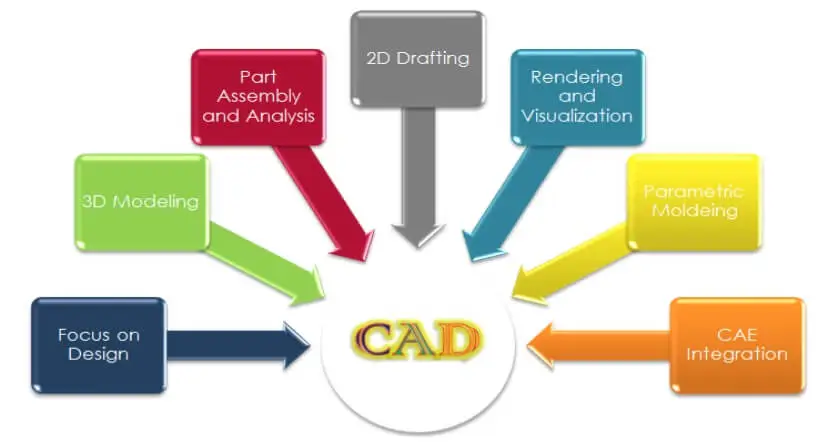In the present day, the design of an engineering object is only a naive idea without the decisive intervention of computer-aided design (CAD), which allows engineers, architects, designers, drafters, and others to create precision drawings and models of the part for subsequent analysis and eventually manufacturing.
Such a chain of computer applications helps surge productivity, plummet material wastages, boost operational efficiencies, and, lastly, aggrandize organizational performance. Some other benefits of using CAD are briefly elaborated on in the figure below.

For different types of modeling practices, individual CAD software has been developed and published over some time to feed seamless modeling needs.
Different Types of CAD Software
In the current article, a few of the sought-after CAD software shall be discussed. These include the following: AutoCAD, AutoCAD Mechanical, SolidEdge, SolidWorks, ProE/Creo, CATIA, Inventor, NX, Rhino 5, Fusion 360, and many others.
AutoCAD
Developed in 1982, AutoCAD is a market leader in 2D drafting. Over time, it gained trust and international clientele, particularly within the realm of 3D printing across industries. It can convert 3D models into STL files for 3D printing.
3D modeling is not as user-friendly as drawing 2D shapes. It is nuanced in programming models algorithmically. In 2011, it was released on mobile as well as web apps known as AutoCAD 360.
AutoCAD Mechanical
Developed as a mechanical version of AutoCAD, Autodesk provides numerous 3D modeling tools for mechanical design.
It provides software solutions, for example, to document CAD models and reuse mechanical drawings. It allows drawing a rectangle from the ribbon, restoring and isolating layer groups, and so forth.
It is equipped with a huge library consisting of more than 700,000 standard mechanical parts with international drafting standards support.
SolidWorks
Being a seamless 3D modeling software for design engineers beyond borders, SolidWorks allows designers to construct innovative mechanical designs. Furnished with a user-friendly interface, developing versatile machinery is no longer a tedious task.
Published by Dassault Systèmes, it is well-liked for being a parametric feature-based model. It offers innumerable compelling tools to the professionals, such as for design validation or reverse engineering.
It uses a system of nonuniform rational B-splines (NURBS). It can create detailed curvatures, and instead of polygon modeling, it uses dimensional sketching to ease re-sizing or editing.
One of its practical disadvantages is its somewhat restricted potential to import STL files. Its current version is SolidWorks 2016 SP2.
Creo/ProE
Developed by Parametric Technology Corporation, ProE is also known by the name PTC Creo or Creo Parametric). It is an outstanding 3D CAD software that caters to assembly modeling (AM), finite element analysis (FEA), and nonuniform rational B-splines (NURBS) surface modeling. It is exclusively designed for mech designers. It goes the extra mile in the rapid prototyping of mechanical parts by providing extraordinary software solutions.
When it was first launched in 1987, it exploded a bombshell in the CAD industry due to its maverick feature known as parametric modeling, with which the constructed piecewise model geometry stored by the program can now be changed by modifying, reordering, and removing the dimensions. Today, CATIA and NX use parametric modeling.
In the late 2010s, ProE was named CreoElements/Pro. It is finally named the Creo design suite.
Being a market leader in product design, Creo integrates functionalities such as thermal, structural, parametric, and, more importantly, freestyle surface generation and direct modeling (DM). Its current version is 3.0.
Inventor
Being the best available modeling program on the market, Inventor offers a myriad of modeling options and top-notch simulation tools to its international clients. Its applications in the field of electrical engineering projects are widespread. Currently, DISTRAN (a company that specializes in intricate steel structure arrangements, i.e., H frame transmission structures) is using Inventor in its electrical design projects.
With time, it matured and became a serious competitor to SolidWorks, ProE-Creo, and SolidEdge. Its current version is Inventor 2016.
CATIA
Developed by Dassault Systèmes in France for its Mirage fighter jet project, CATIA is a professional CAD software. It is mostly used in aerospace (or aerodynamic) analyses. Its superlative 3D CAD tools are the priority of any mechanical engineer to use in optimizing her designs. With CATIA, she can virtually work on any product in any project.
Today, it is a well-known staple at Boeing and many international automobile, aerospace, and naval companies. It has developed into a full PLM solution as one integrated software package for design and FEA analysis. Its later version is CATIA v6 R2014.
SolidEdge
Developed by Siemens, SolidEdge is exclusively designed for mechanical design engineers. In addition to perfect 3D modeling skills, it is also equipped with 2D orthographic view functionality, which is extremely helpful for mechanical design engineers. For CAD purposes, its simulational capabilities are eminently high. Its current version is SolidEdge ST8.
NX
It is another CAD program developed by Siemens PLM software. It fosters a subtle computerized environment to conceptualize, simulate, and manufacture. It supports the designers by providing them with key tools to work on freeform or template-based designs.
It is another CAE/PLM software solution. It is from the company previously known as UGS. This PLM software is a seamless blend of the company’s Unigraphics software and SDRC’s popular I-DEAS software, which UGS took over. Today, Siemens AG owns both UGS and NX. Its current version is NX 10.0.
It is used by General Motors (GM), Rolls Royce, Prat, and Whitney, among many others. More importantly, NX is nuanced to work on sheet metal parts. For example, it can convert solid models into sheet metal components.
Rhino 5
It is the world’s most versatile software par excellence. This 3D modeler is available for both Windows and Mac. Its abilities in modeling are undeniable. Equipped with thousands of modeling and editing tools, Rhino does not disappoint its clients. The designers can now create, edit, analyze, document, render, animate, and translate nonuniform rational B-splines (NURBS), solids, point clouds, and polygon meshes regardless of the storage capabilities of their hardware.
Fusion 360
It is a powerful CAD tool developed by Autodesk. Its most remarkable feature is its cloud-based program, which fosters an excellent communication environment across the team members of the engineering design project. It offers cutting-edge software tools imperative for solid modeling, parametric modeling, and mesh modeling.
Specific 3D Geometry Tools
Specific to FEA (finite element analysis) and CFD (computational fluid dynamics) analysis software used in 3D modeling, a few such geometry tools are discussed below.
ALGOR
Developed by ALGOG Inc. It is the EFA-based general-purpose software package. It is widely used in the aerospace industry. Its wide stretching applications are found in structural, thermal, CFD, acoustic, and electromagnetic simulations. Acquired by Autodesk in 2009, it was renamed as Autodesk simulation.
ANSYS
It is a software company based in Pennsylvania and provides numerous software solutions within the immediate environs of FEA and CFD.
Its flagship product is ANSYS Fluent, which holds up to 40% of the market. It is the industry standard for CFD modeling.
Among many tasks, it imports geometry, creates meshes using GAMBIT and boundary conditions, and resolves complex problems of the fluid flow using Navier-Stokes equations. Its latest release is Fluent 6.3.
All the products are marketed as ANSYS 16.0. It does not provide solutions in the form of Fluent alone; its other packages include electronics, structures, and systems as well.
Discussion
There comes one genuine question to mind: Why have the CAD companies not provided a complete solution to design, test, and manufacture the engineering objects in a single software package?
For several decades, an engineering team designing an aircraft had to create the parts or subsystems in a 3D program, say CATIA, followed by its import into NASTRAN for FEA testing, and then for airflow analysis to CFD and eventually had to send each designed and tested component to CAM for manufacturing.
During this transitioning phase, there were a plethora of hurdles that designers had to come across, such as careful import and export of data files to keep the data from loss as well as the smooth yet complete data transfer needed a lot of time to be expended on the part of the design engineer. So, where lies the solution?
Inevitably, CAE software provided a seamless software solution to the problem mentioned above. It offered one-window shopping to its clientele. One of its examples includes CATIA, which provides workbenches for FEA analysis, and CAM: Code generated by CATIA would now be directly fed to the CNC machine for part manufacturing.
These 3D packages are also referred to as the Product Life Cycle Management (PLM) software. This is not the end of the picture: It became tougher and tougher for CAD companies to offer equally good multi-axial solutions embedded in their respective products; therefore, they are still one notch behind. Mastercam continues to be the king in CAM, whereas NASTRAN is the undisputed leader in FEA analysis.
Frequently Asked Questions
What are different types of CAD softwares?
Some popular 3D CAD software include AutoCAD, AutoCAD Mechanical, SolidEdge, SolidWorks, ProE/Creo, CATIA, Inventor, NX, Rhino 5, Fusion 360, and many others.
What are three CAD softwares that use NURBS geometry?
Three such software are SolidWorks, ProE, and Rhino 5.
I am the author of Mechanical Mentor. Graduated in mechanical engineering from University of Engineering and Technology (UET), I currently hold a senior position in one of the largest manufacturers of home appliances in the country: Pak Elektron Limited (PEL).
